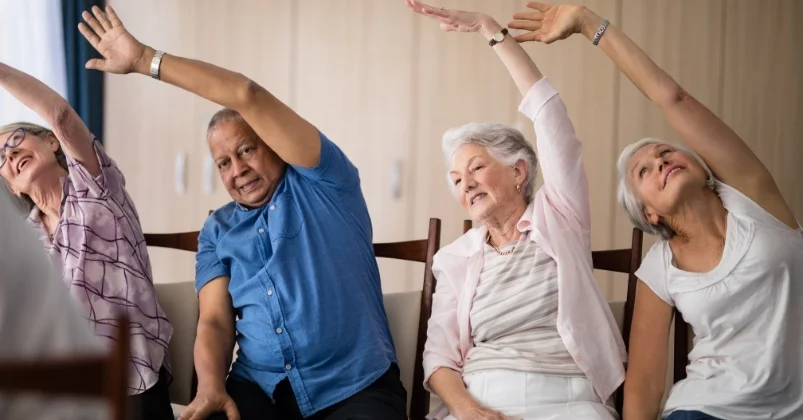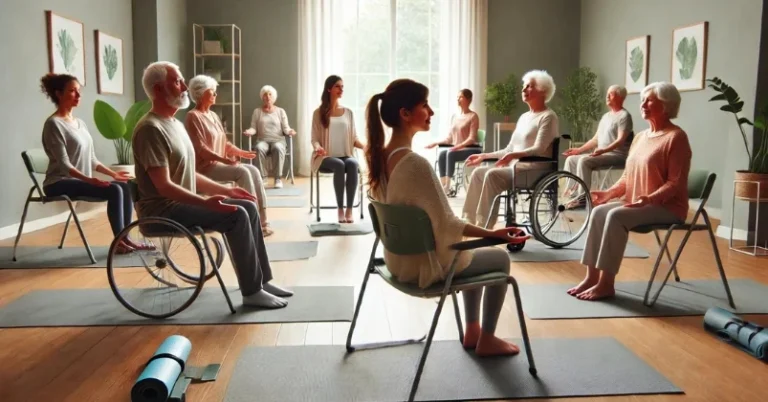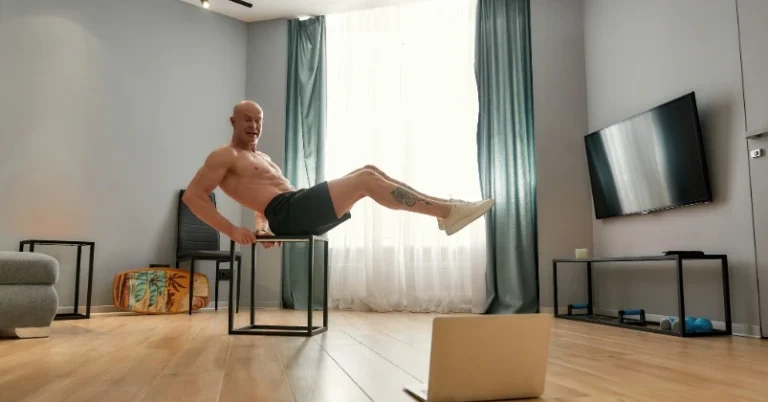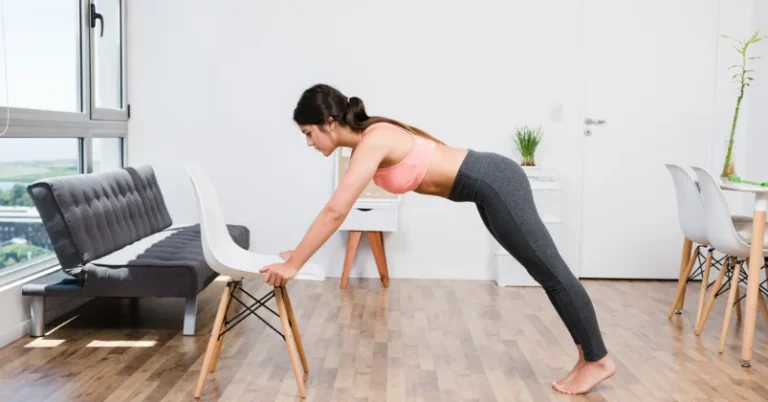Improve Balance and Stability with Chair Exercises for Chronic Conditions
Maintaining balance and stability can be challenging for individuals with chronic conditions such as arthritis, Parkinson's disease, or multiple sclerosis. These conditions can affect the nervous system, muscles, and joints, leading to a higher risk of falls and injuries. However, regular exercise can help improve balance, mobility, and coordination, reducing the risk of falls and improving overall quality of life.
One way to incorporate exercise into a daily routine is through chair exercises. Chair exercises can be done from the comfort of a sturdy chair and can help improve strength, cardiovascular health, mobility, and balance. They are accessible for individuals who haven't maintained an exercise routine over the years or are battling the effects of chronic pain or disability due to injury or health condition. Chair exercises are also a great option for individuals who have limited mobility or are unable to stand for long periods of time.
Understanding Balance and Stability
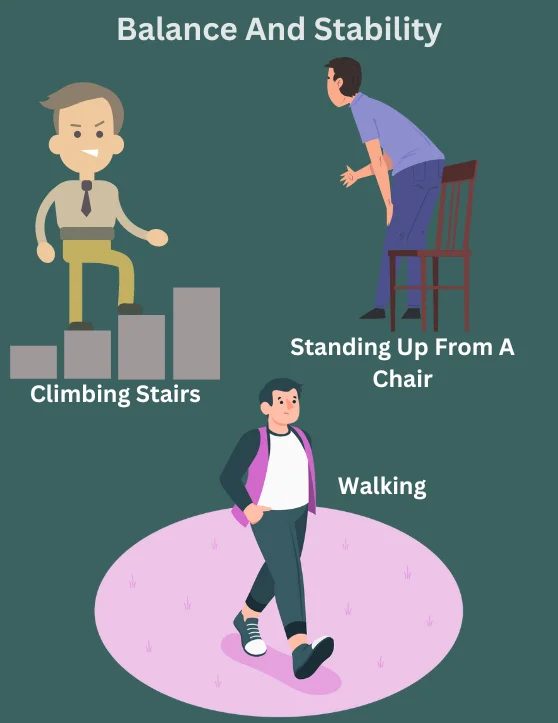
Maintaining good balance and stability is essential for everyday activities such as walking, climbing stairs, and even standing up from a chair. Balance is the ability to maintain control of your body's center of gravity over your base of support, while stability is the ability to maintain that control while standing, sitting, or moving.
Balance and stability are influenced by various factors such as mobility, posture, coordination, reflexes, and muscle strength. As we age, these factors may decline, making us more prone to falls and injuries. However, chronic conditions such as arthritis, Parkinson's disease, or multiple sclerosis can also affect balance and stability.
Fortunately, chair-based exercises can help improve balance and stability, making daily activities more manageable and reducing the risk of falls. Chair-based exercises are safe, simple, and easily implemented physical activities that use a chair to provide stability. These exercises are particularly beneficial for older adults and those who may be frail or deconditioned.
Incorporating chair-based exercises into your daily routine can help improve your overall physical function, including balance and stability. These exercises can also improve mobility, posture, coordination, and reflexes. By engaging in regular physical activity, you can maintain your independence and improve your quality of life.
Importance of Exercise for Chronic Conditions
Exercise is an essential part of maintaining physical health and fitness level, particularly for those with chronic conditions. It can help improve strength, muscle strength, balance, and stability. Physical activity can also help manage symptoms and improve overall health and wellness.
Regular exercise is particularly important for those with chronic conditions such as heart disease, arthritis, chronic pain, high blood pressure, or diabetes. Engaging in physical activity can help manage symptoms and improve overall health and wellness.
Strength training, in particular, can be helpful for individuals with chronic conditions. It can help improve muscle strength, which can help with daily activities and reduce the risk of falls. Chair-based exercises are a great option for those with mobility issues or who are unable to engage in traditional strength training exercises.
In addition to improving physical health, exercise can also have mental health benefits. It can help reduce stress and anxiety, improve mood, and enhance overall quality of life.
It is important to note that individuals with chronic conditions should consult with their healthcare provider before starting an exercise program. A healthcare provider can help develop an exercise plan that is safe and effective for the individual's specific needs and limitations.
Impact of Chronic Conditions on Balance and Stability
Chronic conditions such as stroke, diabetes, heart disease, dementia, cancer, arthritis, multiple sclerosis, vestibular disorders, inner ear disorders, head injuries, vertigo, labyrinthitis, BPV, respiratory infections, deconditioning, COVID-19, asthma, depression, and anxiety can all have a significant impact on an individual's balance and stability.
For instance, individuals with stroke often experience balance issues due to damage to the brain that controls movement and balance. Diabetes can lead to nerve damage, making it difficult to feel sensations in the feet and legs, which can affect balance. Heart disease can cause fatigue and shortness of breath, making it challenging to engage in physical activity that improves balance.
Dementia can cause changes in coordination and spatial awareness, leading to balance problems. Cancer treatments such as chemotherapy can cause weakness and fatigue, which can also affect balance. Arthritis can cause joint pain and stiffness, making it challenging to perform movements that require balance.
Vestibular disorders, inner ear disorders, head injuries, vertigo, labyrinthitis, and BPV can all affect the inner ear, leading to dizziness and balance problems. Respiratory infections such as COVID-19 can cause weakness and fatigue, making it challenging to engage in physical activity that improves balance. Asthma can cause shortness of breath, making it difficult to engage in physical activity that improves balance.
Depression and anxiety can also affect balance and stability. Individuals with depression may experience fatigue and lack of motivation, while those with anxiety may feel dizzy or unsteady due to hyperventilation.
Overall, chronic conditions can have a significant impact on an individual's balance and stability, making it essential to engage in exercises that improve balance and reduce the risk of falls. Chair-based exercises can be an effective way to improve balance and stability while reducing the risk of injury.
Understanding Chair Exercises
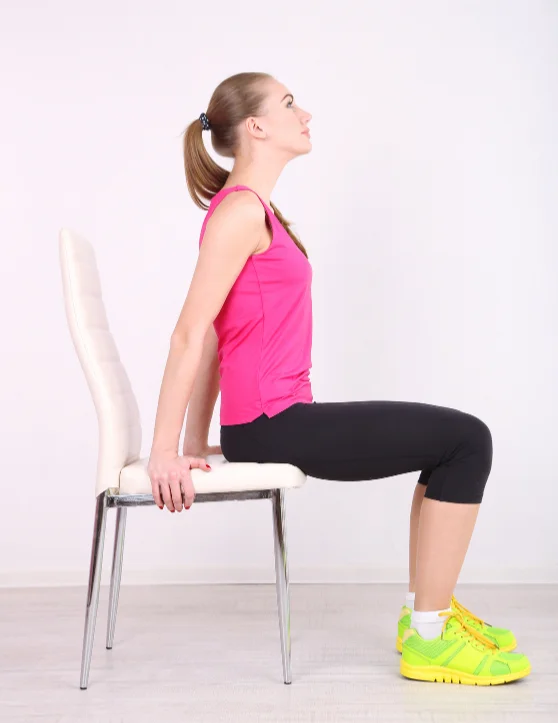
Chair exercises are a type of physical activity that can be done while sitting on a chair. They are a great option for people who have mobility issues or are unable to stand for long periods of time. Chair exercises can be modified to accommodate different fitness levels and can be performed by people of all ages, including seniors and those with chronic conditions.
One of the benefits of chair exercises is that they can be done in a seated position, which makes them accessible to people who may have difficulty standing or balancing. Chair exercises can also help improve balance and stability, which is important for people with chronic conditions such as arthritis, Parkinson's disease, or multiple sclerosis.
Core-strengthening exercises, such as seated leg lifts and seated twists, are a common type of chair exercise. These exercises help to strengthen the muscles in the abdomen, back, and hips, which can improve overall stability and balance.
Chair yoga is another type of chair exercise that combines gentle yoga poses with seated stretches. This type of exercise can help improve flexibility, balance, and range of motion. It can also help reduce stress and promote relaxation.
When performing chair exercises, it is important to start slowly and gradually increase intensity and duration. It is also important to listen to your body and stop if you experience any pain or discomfort. Always consult with your healthcare provider before starting any new exercise program.
Chair exercises are a safe and effective way to improve balance and stability for people with chronic conditions. They can be modified to accommodate different fitness levels and can be performed in a seated position. Chair exercises include core-strengthening exercises and chair yoga, which can help improve overall stability, flexibility, and range of motion.
Benefits of Chair Exercises for Balance and Stability
Chair exercises offer numerous benefits for improving balance and stability, especially for those with chronic conditions. Here are some of the key benefits:
Improve Stability
Chair exercises can help improve overall stability by strengthening the core, legs, and hips. This can help reduce the risk of falls and injuries, especially for older adults or those with chronic conditions. Chair exercises can also help improve posture, which can further enhance stability and balance.
Prevent Falls
Falls are a major concern for older adults, and chair exercises can help reduce the risk of falls by improving balance and stability. Chair exercises can also help improve reaction time, which is important for preventing falls. By improving overall strength and balance, chair exercises can help older adults maintain their independence and reduce the risk of injury.
Independence
For older adults, maintaining independence is important for overall health and well-being. Chair exercises can help improve strength and balance, which can help older adults maintain their independence and perform daily tasks more easily. By improving overall fitness and mobility, chair exercises can help older adults stay active and engaged in their daily lives.
Flexibility
Chair exercises can also help improve flexibility, which is important for maintaining mobility and preventing injuries. By stretching and strengthening muscles, chair exercises can help improve overall flexibility and range of motion. This can help older adults maintain their ability to perform daily tasks and activities.
Aging
As we age, our bodies undergo various changes that can impact balance and stability. Chair exercises can help counteract these changes by improving overall strength, balance, and flexibility. By incorporating chair exercises into a daily routine, older adults can help maintain their overall health and well-being as they age.
“Balance, Strength, and Stability: The Transformative Impact of Chair Exercises”
Overall, chair exercises offer numerous benefits for improving balance and stability, especially for those with chronic conditions. By improving overall strength, balance, and flexibility, chair exercises can help reduce the risk of falls and injuries, improve independence, and maintain overall health and well-being.
Specific Chair Exercises for Balance and Stability
Chair exercises are a great way to improve balance and stability for those with chronic conditions. Here are a few specific chair exercises that can help improve balance and stability:
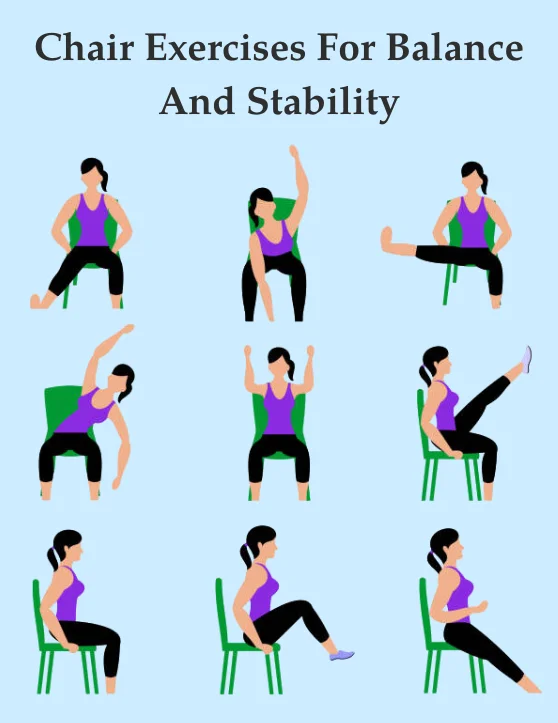
- Heel-to-toe walk: Sit at the edge of the chair with your feet flat on the ground. Place one foot in front of the other, heel to toe. Try to maintain this position for a few seconds before switching feet. This exercise helps improve balance and coordination.
- Tightrope walk: Sit at the edge of the chair with your feet flat on the ground. Lift one foot and place it in front of the other, as if walking on a tightrope. Hold this position for a few seconds before switching feet. This exercise helps improve balance and stability.
- Rock the boat: Sit at the edge of the chair with your feet flat on the ground. Slowly shift your weight to one side, lifting the opposite foot off the ground. Hold this position for a few seconds before switching sides. This exercise helps improve balance and stability.
- Flamingo stand: Sit at the edge of the chair with your feet flat on the ground. Lift one foot off the ground and hold it in the air for a few seconds. Repeat with the other foot. This exercise helps improve balance and stability.
- Squats: Sit at the edge of the chair with your feet flat on the ground. Slowly stand up, using your legs to lift yourself up. Hold this position for a few seconds before slowly sitting back down. This exercise helps improve leg strength and stability.
- Hamstring curl: Sit at the edge of the chair with your feet flat on the ground. Slowly lift one foot off the ground and bring your heel towards your buttocks. Hold this position for a few seconds before lowering your foot back down. Repeat with the other foot. This exercise helps improve balance and stability.
Remember to always consult with your healthcare provider before starting any new exercise routine.
Role of Different Muscle Groups in Balance
Maintaining balance requires a coordinated effort from various muscle groups in the body. These muscles work together to keep our body upright and stable. Here are some of the muscle groups that play a vital role in maintaining balance:
Core Muscles
The core muscles, including the abdominal and lower back muscles, are essential for maintaining balance. These muscles help stabilize the spine and pelvis, which are critical for maintaining proper posture and balance. A strong core can also help prevent falls and injuries.
Glutes
The glutes, or the muscles in the buttocks, are also crucial for maintaining balance. These muscles help stabilize the hips and pelvis, which are essential for maintaining proper posture and balance. Weak glutes can lead to instability and increase the risk of falls.
Legs
The muscles in the legs, including the quadriceps, hamstrings, and calf muscles, play a vital role in maintaining balance. These muscles help support the body's weight and provide stability during movement. Weak leg muscles can lead to instability and increase the risk of falls.
It is essential to maintain strong and flexible leg muscles to improve balance and prevent falls. Exercises like squats, lunges, and calf raises can help strengthen the leg muscles.
Lower Back
The lower back muscles are also vital for maintaining balance. These muscles help stabilize the spine and pelvis, which are critical for maintaining proper posture and balance. Weak lower back muscles can lead to instability and increase the risk of falls.
Exercises like back extensions and bird dogs can help strengthen the lower back muscles and improve balance.
Maintaining balance requires a coordinated effort from various muscle groups in the body. A strong core, glutes, legs, and lower back muscles are essential for maintaining proper posture and stability. Regular exercise and strength training can help improve these muscle groups and reduce the risk of falls and injuries.
Safety Considerations and Precautions
When performing chair exercises to improve balance and stability, it is important to keep safety considerations in mind to prevent any potential injuries. Here are some precautions to take:
- Consult with a healthcare professional: Before starting any new exercise program, it is important to consult with a healthcare professional, especially if you have a chronic condition or disability that affects your balance or stability.
- Use a sturdy chair: Make sure to use a sturdy chair with a backrest and armrests that can support your weight and provide balance and stability.
- Clear the area: Clear the area around your chair of any objects or obstacles that could cause you to trip or fall.
- Wear appropriate footwear: Wear comfortable, supportive footwear with non-slip soles to prevent slipping and falling.
- Avoid exercises that cause dizziness: If you experience dizziness during any of the exercises, stop immediately and rest until the dizziness subsides.
- Modify exercises for back pain: If you have back pain, modify the exercises to avoid any movements that cause discomfort or pain.
- Adapt exercises for disabilities: If you have a disability that affects your balance or stability, adapt the exercises to your abilities and limitations.
By taking these precautions, you can perform chair exercises safely and effectively to improve your balance and stability and reduce the risk of falls and injuries.
Role of Physical Therapist in Balance Training
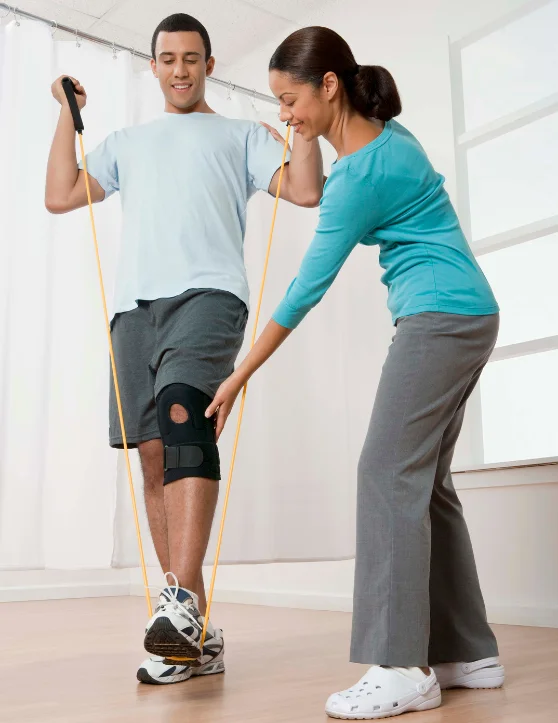
Physical therapists play a crucial role in designing and implementing balance training programs for individuals with chronic conditions. They are trained to evaluate a patient's current level of balance and stability and design an exercise program tailored to their specific needs.
The physical therapist will start by assessing the patient's balance and stability using various tests and measures. Based on the results, they will design an exercise program that includes exercises to improve balance, strength, and flexibility. The exercise program will be tailored to the patient's specific needs and abilities.
The physical therapist will guide the patient through the exercise program, ensuring that they are performing the exercises correctly and safely. They will also monitor the patient's progress and make adjustments to the exercise program as needed.
It is important to note that balance training is not a one-size-fits-all approach. The physical therapist will adjust the exercise program based on the patient's progress and feedback. They may increase the number of repetitions or resistance of the exercises as the patient gets stronger.
In addition to designing and implementing the exercise program, the physical therapist will also focus on teaching the patient how to maintain their balance and stability in daily activities. They will teach the patient how to use proper body mechanics and posture to prevent falls and injury.
Overall, the role of the physical therapist in balance training is to design and implement a safe and effective exercise program tailored to the patient's specific needs and abilities. They will guide the patient through the program, monitor their progress, and teach them how to maintain their balance and stability in daily activities.
Impact of Lifestyle Factors on Balance and Stability
Maintaining good balance and stability is crucial for people with chronic conditions, as it can help prevent falls and other injuries. While chair exercises can be an excellent way to improve balance and stability, lifestyle factors can also play a significant role in maintaining good balance.
Walking
Walking is an excellent way to improve balance and stability, as it engages the muscles in the legs and core. Regular walking can help improve overall fitness, which can, in turn, improve balance and stability. Walking can also help improve bone density, which can help prevent fractures and other injuries.
Sports and Activities of Daily Living
Participating in sports or other activities can also help improve balance and stability. Activities that involve balance, such as yoga or tai chi, can be particularly beneficial. Additionally, engaging in regular activities of daily living, such as cleaning or gardening, can help improve overall fitness and balance.
Alcohol
Excessive alcohol consumption can have a negative impact on balance and stability. Alcohol can impair coordination and reaction time, making it more likely for someone to fall or injure themselves. It is essential to drink alcohol in moderation or avoid it altogether to maintain good balance and stability.
Medications
Certain medications can also affect balance and stability. For example, some medications used to treat high blood pressure or anxiety can cause dizziness or lightheadedness, which can increase the risk of falls. It is essential to talk to a healthcare provider about any medications that may affect balance and stability and to follow their recommendations.
While chair exercises can be an excellent way to improve balance and stability, lifestyle factors such as walking, participating in activities, limiting alcohol consumption, and managing medications can also play a significant role. By incorporating these lifestyle factors into a daily routine, individuals with chronic conditions can improve their overall health and reduce the risk of falls and other injuries.
Recommendations from Health Organizations
Health organizations recommend chair-based exercises as a safe and effective way to improve balance and stability in older adults and those with chronic conditions. The American College of Sports Medicine recommends that older adults perform exercises that improve balance and reduce the risk of falls at least two times per week, with chair-based exercises being a viable option for those with limited mobility.
A systematic review of chair-based exercise programs found that they are effective at improving strength and balance in older adults and those with chronic conditions, with a low risk of overall bias. This suggests that chair-based exercises should be promoted as simple and easily implemented activities to maintain and develop strength and offset the negative effects of physical inactivity in older adults and vulnerable populations who may be self-isolating.
Cardiovascular disease is a common chronic condition that can benefit from chair-based exercises. Physical activity can improve heart health by reducing blood pressure, improving cholesterol levels, and reducing the risk of heart disease. Chair-based exercises can be a safe and effective way for those with cardiovascular disease to improve their physical activity levels and reduce their risk of further complications.
Chair-based exercises are a safe and effective way to improve balance and stability in older adults and those with chronic conditions. Health organizations recommend incorporating chair-based exercises into a regular exercise routine to maintain and develop strength and offset the negative effects of physical inactivity.
FAQs
A: Chair exercises that can improve balance and stability for chronic conditions include seated leg lifts, seated marches, and seated heel raises. These exercises help to strengthen the muscles in the legs and improve stability.
A: Coordination exercises can benefit those with chronic conditions by improving their ability to control their movements. These exercises can include activities such as tapping the feet or hands in a specific pattern, or performing simple movements with the arms and legs in a coordinated manner.
A: Effective strength and balance exercises for seniors at home include standing on one foot, heel-to-toe walking, and side leg lifts. These exercises help to improve balance and coordination, as well as strengthen the muscles in the legs.
A: Easy balance exercises for seniors to try include standing on one foot while holding onto a chair, or walking heel-to-toe in a straight line. These exercises can be done at home and require no special equipment.
A: Sitting in a chair can improve balance by providing a stable base from which to perform exercises. Chair exercises that incorporate movements such as lifting the legs or arms can help to improve balance and stability.
A: The best exercises for improving balance in seniors with chronic conditions include a combination of strength training, coordination exercises, and balance exercises. These exercises can be tailored to the individual's abilities and should be performed under the guidance of a healthcare professional.

